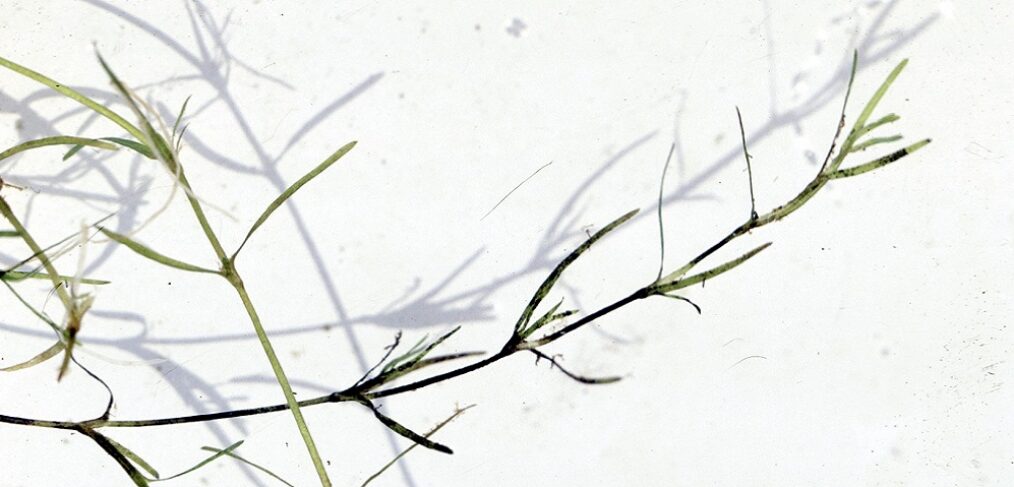
Species of the week #110 – nodding waternymph
The nodding waternymph grows where the water mermaids live, according to an Austrian legend. Unfortunately, the mermaids seem to have emigrated in the 1970s. Since then, there have been nodding waternymphs in Germany. Lake Millstätter See in Carinthia, Austria, seems to take better care of the mermaids: Lake Millstätter See was declared an FFH protected area in 2002, mainly because of the occurrence of the nodding waternymphs, and is the closest possibility from Germany to see the nodding waternymph in the wild.
| Distribution Status in Germany | Extinct |
| Remaining occurances | Ireland, Sweden, Austria |
| Last sightning in Germany | 1980 at Lake Constance |
| Habitat | Nutrient-poor, calcareous freshwater lakes |
| Threat | Water pollution |
The nodding waternymph is endangered throughout Europe. The largest populations are still in Ireland, with smaller occurrences in Scotland, Sweden and Austria. It is deciduous, annual and found in shallow water zones of nutrient-poor freshwater lakes. It grows completely submerged with five to 30 centimetre long, flexible and richly branched stems at the bottom of the lake, in good light conditions even down to a depth of six metres in large waving carpets. Even at flowering time, the shoots with the inconspicuous flowers do not reach the water surface. The pollination of the blossoms takes place completely under water, solely through the current. This type of pollination is called hydrophilia; it is very rarely found in seed plants. In autumn, the plant dies and the seeds initially float on the water until they finally sink to the bottom. Germination experiments with Scottish plant material showed that the seeds germinate best after a cold period of several months in the light under oxygen-free conditions and temperatures > 16°C. Seed survival on dry land, e.g. at very low water levels, is also possible.
The interaction of the various plant characteristics, such as the one-year life span, the lack of vegetative reproduction, the submerged way of life and the undirected pollination of the flowers by the water, make the species extremely sensitive to external influences and habitat changes. The nodding waternymph depends on particularly clear and clean water. Nutrient discharges through sewage, agricultural inputs, acid rain and other pollution, can lead to loss of seed production and reduced plant growth.
The alkalinisation of water bodies that accompanies nutrient inputs is also disadvantageous, since at higher pH values hydrogen carbonate or carbonate is increasingly present instead of free carbon dioxide. Hydrogen carbonate can be used by most competing aquatic plant species, but not by mermaid weed. It can only use free CO2 as a carbon source.
The species is considered a relict of earlier warm phases after the last ice age, during which, according to fossil finds, it was able to colonise a much larger area.
In Germany, the Nodding Waternymph is considered lost, as the last record from Lake Constance dates back more than 40 years. In Lake Constance, the last specimens became extinct in the mid-1970s with the increase in the nutrient content of the water. Only since the 1980s has the nutrient load there been decreasing again, but the Nodding Waternymph can no longer be found there. In the North German Lowlands, where the species was very rare anyway, it has also been extinct for a long time.
For Germany, the Nodding Waternymph is actually a species of responsibility, i.e. a species that must be given special attention and measures taken because of its unique occurrence. At present, however, no direct measures can be taken to conserve the species, as no native plant material is available in the form of seeds or conservation crops.
Policy Needed:
- Restoration of the original condition of the former settlement waters with appropriately nutrient-poor water conditions.
- Funding of research and conservation projects to find and reintroduce them at suitable sites.
Click here for more exciting species of the week
Photo : By Robert H. Mohlenbrock @ USDA-NRCS PLANTS Database / USDA NRCS. 1995. northeast wetland flora: field office guide to plant species. Northeast National Technical Center, Chester. – http://plants.usda.gov/java/largeImage?imageID=nafl_002_ahp.tif, Public Domain, https://commons.wikimedia.org/w/index.php?curid=6229128
